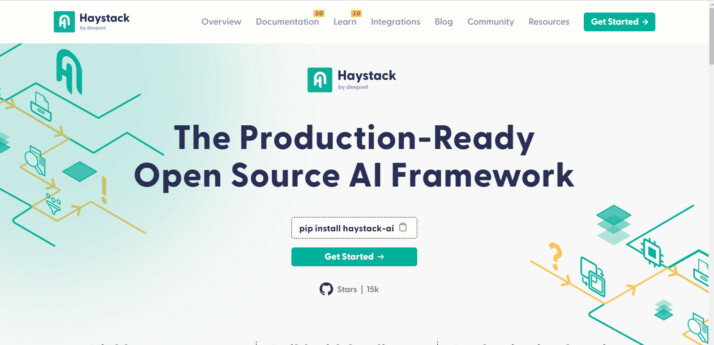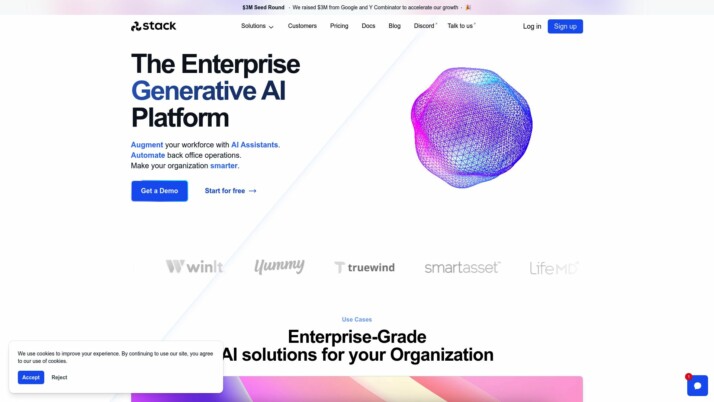Artificial intelligence platforms Haystack vs. Stack AI offer developers and businesses powerful tools to harness AI capabilities, but each takes a distinct approach. This comparison examines how these platforms stack up against SmythOS, our comprehensive AI development solution. We explore key features, use cases, and deployment options to help you determine which platform best fits your AI ambitions. Whether you’re a seasoned developer seeking flexible NLP tools or a business user looking for accessible AI workflows, this analysis provides the insights needed to make an informed decision in today’s competitive AI landscape.
Haystack Overview
Haystack empowers developers to build robust NLP applications using large language models and vector search. This open-source framework excels at retrieval-augmented generation, question answering, and conversational AI.

Haystack’s modular architecture allows developers to craft custom search experiences and chatbots by integrating tools like Hugging Face Transformers, Elasticsearch, and OpenAI into flexible pipelines. Its support for various NLP tasks and integration with popular AI models makes it a versatile choice for building production-ready applications.
Haystack’s modular architecture allows developers to craft custom search experiences and chatbots by integrating tools like Hugging Face Transformers, Elasticsearch, and OpenAI into flexible pipelines.
Developed by deepset GmbH, Haystack complements their commercial offering, deepset Cloud. This SaaS platform streamlines the entire lifecycle of NLP application development, from prototyping to production deployment. deepset Cloud provides pre-built workflows, collaborative tools, and templates for common LLM setups, enabling teams to focus on innovation while the platform handles AI operations.
Haystack’s strengths lie in its flexibility and extensive integration options. However, it lacks a visual builder or no-code editor, which may present a steeper learning curve for non-technical users. The framework’s reliance on code-based interaction might limit accessibility for those seeking drag-and-drop simplicity.
Despite this limitation, Haystack’s robust features, including support for multimodal retrieval, explainable AI outputs, and collaborative development tools, position it as a powerful option for teams with technical expertise. Its ability to handle large-scale document processing and seamless integration with various AI models and databases make it well-suited for complex NLP projects across industries.
Stack AI Overview
Stack AI empowers users to create and deploy AI-powered workflows and custom AI assistants without extensive coding expertise. The platform’s low-code approach democratizes access to advanced AI capabilities, making it accessible to a wide range of users from developers to business professionals.
Stack AI’s no-code interface features a user-friendly drag-and-drop system, allowing rapid development of AI applications. The platform prioritizes enterprise-grade security, complying with SOC 2, HIPAA, and GDPR standards to ensure data protection and privacy. Users can deploy their AI solutions through customizable interfaces or API endpoints, offering flexibility in implementation.

Stack AI empowers users to create and deploy AI-powered workflows and custom AI assistants without extensive coding expertise. The platform’s low-code approach democratizes access to advanced AI capabilities…
The platform boasts extensive integrations with popular services like Google Drive, Salesforce, Airtable, and Slack, enhancing its utility across various business processes. Stack AI provides high-touch customer support from experienced AI professionals, facilitating smooth implementation and operation of AI projects. A library of pre-built templates for common use cases accelerates development, allowing users to quickly adapt and customize AI solutions to their specific needs.
Stack AI has successfully delivered AI solutions across various industries. Examples include a Physician Co-Pilot that assists doctors in retrieving patient information and generating SOAP reports, a Hospital CSR Assistant for drafting patient inquiry responses, and an Investment Memo Generator that combines information from Google searches with specific guidelines.
While Stack AI offers powerful capabilities, it may face challenges in highly specialized or complex AI implementations that require deep customization. The platform’s focus on accessibility and ease of use could potentially limit its appeal to advanced users seeking granular control over AI models and algorithms. Additionally, as with many cloud-based platforms, users should carefully consider data privacy and security implications when handling sensitive information.
Feature Comparison
Haystack and Stack AI offer distinct approaches to AI development, each with its own strengths and limitations. Haystack excels in providing a flexible, code-based framework for building advanced NLP applications. Its modular architecture allows developers to craft custom pipelines integrating various AI models and tools. However, Haystack lacks visual building tools, potentially limiting accessibility for non-technical users.
Stack AI, in contrast, emphasizes a low-code approach with its drag-and-drop interface, making AI development more accessible to a broader audience. This visual builder streamlines the creation of AI workflows and assistants, though it may sacrifice some of the granular control offered by Haystack’s code-based system. Stack AI’s focus on enterprise-grade security compliance (SOC 2, HIPAA, GDPR) addresses a critical need for businesses handling sensitive data, an area where Haystack’s documentation is less explicit.
While both platforms support the deployment of AI solutions, their approaches differ significantly. Haystack’s strength lies in its extensive integration options and support for advanced NLP tasks, making it well-suited for complex, customized implementations. Stack AI’s pre-built templates and user-friendly interface cater more to rapid development and deployment of AI assistants across various business processes, potentially sacrificing some of the depth offered by Haystack’s more technical approach.
Feature Comparison Table
| Haystack | Stack AI | SmythOS | |
|---|---|---|---|
| CORE FEATURES | |||
| Visual Builder | ❌ | ✅ | ✅ |
| No-Code Options | ❌ | ✅ | ✅ |
| Agent Work Scheduler | ❌ | ✅ | ✅ |
| SECURITY | |||
| Constrained Alignment | ❌ | ❌ | ✅ |
| IP Control | ❌ | ❌ | ✅ |
| COMPONENTS | |||
| Huggingface AIs | ✅ | ❌ | ✅ |
| Zapier APIs | ❌ | ✅ | ✅ |
| Data Lakes | ❌ | ✅ | ✅ |
| DEPLOYMENT OPTIONS (EMBODIMENTS) | |||
| Staging Domains | ❌ | ✅ | ✅ |
| Production Domains | ❌ | ✅ | ✅ |
| Deploy as Scheduled Agent | ❌ | ❌ | ✅ |
| DATA LAKE SUPPORT | |||
| Sitemap Crawler | ❌ | ❌ | ✅ |
| YouTube Transcript Crawler | ❌ | ❌ | ✅ |
Best Alternative to Haystack and Stack AI
SmythOS emerges as the superior alternative to Haystack and Stack AI, offering a comprehensive platform for AI agent development and deployment. Our solution combines the best of both worlds — the flexibility of Haystack’s modular architecture and the user-friendliness of Stack AI’s low-code approach.
We pride ourselves on our intuitive drag-and-drop interface, which democratizes AI development without sacrificing advanced capabilities. Unlike Haystack’s code-heavy approach, SmythOS allows users of all technical backgrounds to create sophisticated AI agents. At the same time, we offer more granular control and customization options than Stack AI, ensuring that even the most complex AI workflows can be implemented with ease.
SmythOS emerges as the superior alternative to Haystack and Stack AI, offering a comprehensive platform for AI agent development and deployment.
Our platform excels in its extensive feature set, addressing critical gaps left by both Haystack and Stack AI. SmythOS supports a wide array of AI models, including integration with Hugging Face, which Haystack offers but Stack AI lacks. We also provide Zapier API integration, a feature absent in Haystack but present in Stack AI, enhancing our platform’s connectivity with various tools and services.
Unique to SmythOS is our Agent Work Scheduler, a feature missing from both Haystack and Stack AI. This functionality allows for intelligent, automated task management, significantly boosting productivity and efficiency in AI agent operations. Additionally, our platform offers unparalleled deployment flexibility, including options to deploy as scheduled agents — a capability neither Haystack nor Stack AI provides.
With SmythOS, users gain access to cutting-edge features like constrained alignment and IP control, ensuring enhanced security and ethical AI practices. Our platform also supports data lake integration and offers advanced web crawling capabilities, including sitemap and YouTube transcript crawling — features not available in either Haystack or Stack AI. This comprehensive approach makes SmythOS the ideal choice for businesses and developers looking to harness the full potential of AI agent technology.
Conclusion
Haystack, Stack AI, and SmythOS each offer unique approaches to AI development and deployment, catering to different user needs and expertise levels. Haystack excels in providing a flexible, code-based framework for advanced NLP applications, while Stack AI emphasizes accessibility with its low-code platform for AI workflows and assistants. Both platforms have their strengths, but SmythOS emerges as the superior choice for businesses seeking a comprehensive, user-friendly AI solution.
SmythOS stands out with its unparalleled combination of power and accessibility. Our drag-and-drop interface simplifies complex AI workflows, making advanced capabilities accessible to users across technical skill levels. With support for over 300,000 integrations and compatibility with leading AI models, SmythOS offers unmatched versatility. The platform’s ’Create Once, Deploy Anywhere’ philosophy ensures that AI agents can be seamlessly integrated into various environments, from chatbots to APIs, enhancing operational efficiency across multiple channels.
While Haystack and Stack AI have their merits, SmythOS provides a more comprehensive solution for businesses looking to harness the full potential of AI. Our platform not only simplifies AI development but also offers robust features like multi-agent collaboration, advanced security measures, and scalable deployment options. These capabilities position SmythOS as the ideal choice for organizations aiming to drive innovation and efficiency through AI.
To experience the transformative power of SmythOS for yourself, we invite you to create a free SmythOS account. Start building AI agents at no cost, with no time limit, and see how SmythOS can revolutionize your approach to AI development and deployment. For those seeking inspiration, explore our diverse range of AI-powered agent templates to jumpstart your projects. Unleash the potential of AI for your business today with SmythOS – where innovation meets simplicity.